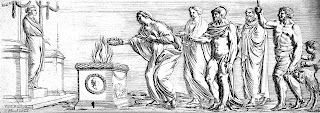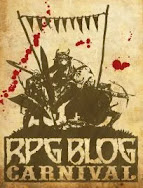If you like what you read, check out last week's article on evil cults. If that's not to your liking there's also D66 graveyard encounters!
Technomagical Prosthetics
Sometimes when I’m bored, I like
to look at non-fantasy RPGs to see if there’s anything cool I can mine for my OSR
campaigns. I’m not necessarily looking for new mechanics, just interesting ways
of handling genre tropes. This is what led me to write this article. I’ve been
looking at cyberpunk games over the past few months, seeing what might be
interesting about the way they handle the tropes inherent in their genre. While
I don’t think I’ll be running one anytime soon, cyberpunk campaigns do have
lots of interesting goodies that could be fun to flip into a fantasy game. That’s
when I came up with the idea of technomagical prosthetics - essentially fantasy
cyberwear. The following spells and magic items allow you to add powerful magical
prosthetics to your campaigns.
How do they work?
These ancient magical items we
created long ago by a mysterious order of mages now lost to history. The mages
that created them called them Vestiges. These magical items are bonded to a recipient’s
body but empowered by their soul. The spells below will allow a magic user to channel
the flow of the recipient’s soul into a Vestige, much the way one’s spirit
flows through any other part of one’s body. As well, there is a spell to
reverse the procedure and excise a Vestige. Though legends tell of many Vestiges,
they are unique items and no two grant the same powers or capabilities.
New Spells
Technomagical Convergence
5th Level Magic-User
Spell
Duration: Permanent
Range: Touch
A single target human, demihuman,
or human-like monster must make a Paralysis saving throw with a +2 bonus.
If they succeed, the target is successfully attached to the Vestige of the
caster’s choosing at the time of casting. If the target fails the saving throw,
they lose half their Hit Points (rounded down). In addition, they can never be
bonded to that specific Vestige again. (A Vestige can replace a body part
without that part having to already be missing. The body part will dissolve off
of the target’s body at the time of casting.)
Restrictions: Undead,
constructs, and other such creatures lacking a soul are not affected.
Technomagical Disjunction
5th Level Magic-User
Spell
Duration: Instant
Range: Touch
This spell causes a single target
to become unbonded to a Vestige they are attached to. The target must make a
saving throw versus Spells. If they fail, they take 3d8 damage and
suffer a -2 penalty to saving throws for the next 24 hours. If they succeed,
they suffer half damage only.
Restrictions: Undead,
constructs, and other such creatures lacking a soul are not affected.
Technomagical Vestiges
The items below can only be used
if they are attached to a target by the spell Technomagical Convergence, otherwise
they are just inert sculptures of body parts. If attached properly, they grant
a special ability; either a continuous effect or a short-use power that can be
utilized a certain amount of time a day equal to half the Vestige bearer’s
level rounded up. A power should be considered continuous unless there is a “*”
in the power’s description.
|
Body Part |
Description |
Power |
|
Eye |
A polished sphere the size of a human eye made of red obsidian with a
pupil of inlayed ebony wood. |
The Vestige grants the possessor Darkvision up to 30 feet for ten
minutes at a time.* |
|
Eye |
The top quarter of a head and the left eye constructed from different
colored marbles. The eye is made of red, yellow, green, blue, and purple
marble, the forehead is made of red marble, and the eyebrow is carved of
green marble. |
This Vestige grants the possessor the ability to see invisible
creatures and illusions up to 50 feet away for ten minutes at a time.* |
|
Eye |
A polished stone sphere the size of a human eye made of polished black
obsidian with a cats-eye-jade pupil. |
This Vestige grants the possessor the ability to see magic and its effects
as auras up to 30 feet away for ten minutes at a time.* |
|
Arm |
A hand and forearm carved of gray marble with the back of the hand
and fingers made of polished carnelian.
The forearm is wrapped in bands of bronze carved with ancient runes. |
This Vestige allows the possessor to perfectly conceal a dagger blade
in their forearm that can fold out at will. |
|
Arm |
A pair of arms and hands. The biceps are made of oiled walnut wood. Attached
to them are arms of carved and polished pink agate. The hands are made of
articulated brass with copper pins. |
This Vestige grants the possessor a 5-in-6 chance of opening stuck
doors and other such feats of strength. |
|
Arm |
A sculpted arm and hand. The arm is constructed of inlayed strips of green
jade and gray marble, and the hands are carved of polished white marble. |
This Vestige perfectly conceals a small compartment in the forearm large
enough to fit a palm-sized object. |
|
Arm |
A left forearm and hand. The forearm is made of cast iron with blue
crystal inlayed on top, and the hand is sculpted out of gray-blue marble. |
This Vestige can create a scintillating energy shield attached to the
forearm. This shield negates the next successful attack against the possessor.
The shield remains for an hour after it has been activated.* |
|
Legs |
A pair of legs constructed of polished sandstone thighs and shins
with iron knees, ankles, and feet. |
This Vestige prevents the possessor’s speed from becoming slower than
60’ (20’) due to encumbrance. |
|
Legs |
A pair of mechanical legs made of iron, copper, and brass braces,
springs, gears, and pistons. |
This Vestige grants the possessor a vertical jump distance equal to
their Constitution score in feet for up to an hour at a time.* |
|
Legs |
A pair of verdigris-encrusted brass legs and feet with polished green
jade toes and gold knees. |
This Vestige grants the possessor a swim speed equal to their normal movement
rate for up to an hour at a time.* |
|
Legs |
A pair of legs expertly made out of carved and polished blocks of walnut,
ash, and hickory inlayed with copper vines. |
This Vestige grants the possessor a 3-in-6 chance of moving silently.
|
|
Throat |
A collar carved in the shape of a neck. Made out of blue and green
marble and red carnelian. |
This Vestige’s possessor does not need to breath. |
|
Forearms, shins, and shoulders |
Plates of green jade, red marble, and amethyst permanently attached
to the forearms, shins, and shoulders. |
This Vestige grants a +2 AC bonus to its possessor. |
|
Shoulders |
Shoulder blades of red marble, carnelian, and ruby carved with motifs
of flames. |
This Vestige’s possessor takes half damage from fire attacks and is
unaffected by non-magical heat. |
|
Hands and feet |
Stone hands and feet carved of inlayed blue marble, aquamarine, and
blue topaz. |
This Vestige’s possessor takes half damage from cold attacks and is
unaffected by non-magical cold temperatures. |
|
Forearms, shins, and shoulders |
Thin plates of mica and green crystal attached to the forearms, shins,
and shoulders, inscribed with ancient magic runes. |
This Vestige bends light around the possessor, granting them a 3-in-6
chance to hide in shadows. |













